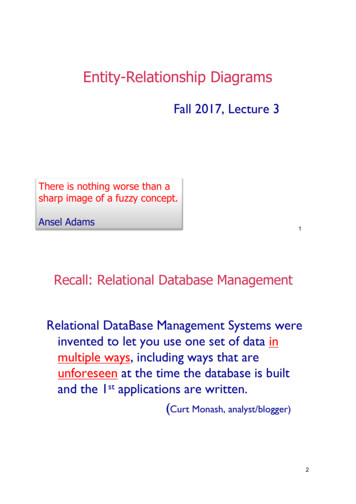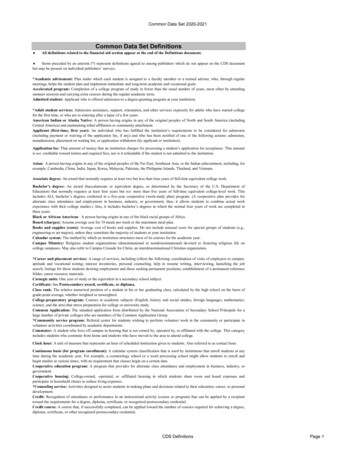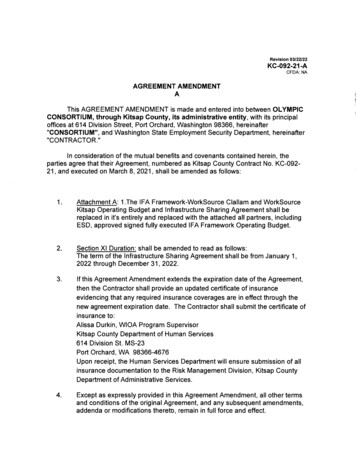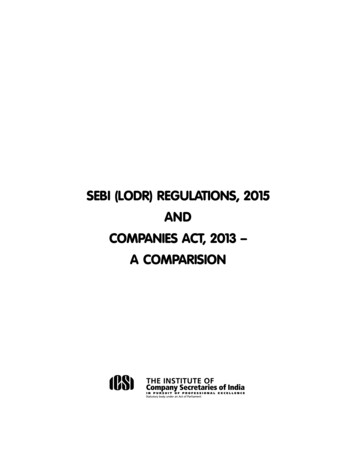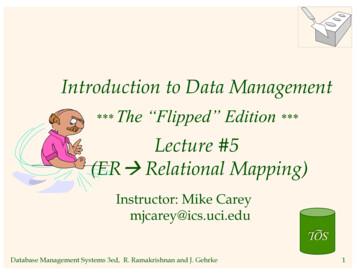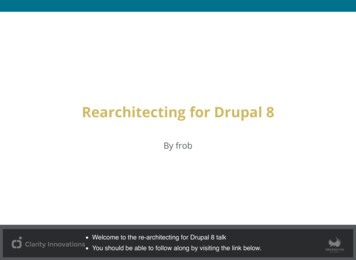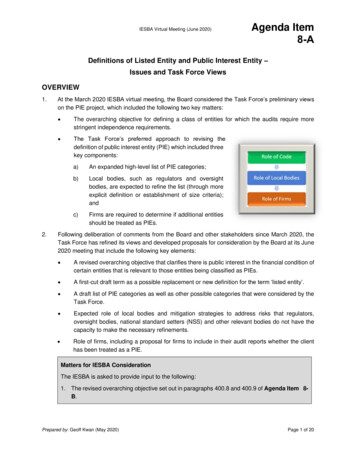
Transcription
IESBA Virtual Meeting (June 2020)Agenda Item8-ADefinitions of Listed Entity and Public Interest Entity –Issues and Task Force ViewsOVERVIEW1.2.At the March 2020 IESBA virtual meeting, the Board considered the Task Force’s preliminary viewson the PIE project, which included the following two key matters: The overarching objective for defining a class of entities for which the audits require morestringent independence requirements. The Task Force’s preferred approach to revising thedefinition of public interest entity (PIE) which included threekey components:a)An expanded high-level list of PIE categories;b)Local bodies, such as regulators and oversightbodies, are expected to refine the list (through moreexplicit definition or establishment of size criteria);andc)Firms are required to determine if additional entitiesshould be treated as PIEs.Following deliberation of comments from the Board and other stakeholders since March 2020, theTask Force has refined its views and developed proposals for consideration by the Board at its June2020 meeting that include the following key elements: A revised overarching objective that clarifies there is public interest in the financial condition ofcertain entities that is relevant to those entities being classified as PIEs. A first-cut draft term as a possible replacement or new definition for the term ‘listed entity’. A draft list of PIE categories as well as other possible categories that were considered by theTask Force. Expected role of local bodies and mitigation strategies to address risks that regulators,oversight bodies, national standard setters (NSS) and other relevant bodies do not have thecapacity to make the necessary refinements. Role of firms, including a proposal for firms to include in their audit reports whether the clienthas been treated as a PIE.Matters for IESBA ConsiderationThe IESBA is asked to provide input to the following:1. The revised overarching objective set out in paragraphs 400.8 and 400.9 of Agenda Item 8B.Prepared by: Geoff Kwan (May 2020)Page 1 of 20
Definitions of Listed Entity and PIE – Issues and TF ViewsIESBA Virtual Meeting (June 2020)2. Category (a) of the proposed list of PIE categories as a first-cut draft of a possible definitionof the term “listed entity,” including whether entities “in the process of being publicly traded”should be included.3. Category (b) to (f) of the proposed list of PIE categories as well as the Task Force’sconsideration of other types of entities.4. Whether other categories, in particular “custodian,” should be added to the proposed list ofPIE categories.5. Expected role of local bodies and the role of firms under Approach 2.6. Any other relevant matters.INFORMATION GATHERING ACTIVITIES SINCE MARCH 20203.The Task Force Chair presented the Task Force’s preliminary view at the Forum of Firms’ virtualmeeting in March 2020 and the joint IESBA-IAASB NSS virtual meeting in May 2020. The Task Forcealso sought written input from participants of these meetings with respect to how the term “listedentity” is applied and whether any public markets are scoped out.4.Members of the Task Force also held informal meetings with a small number of stakeholdersincluding South Africa’s Independent Regulatory Board for Auditors (IRBA), Australia’s AccountingProfessional & Ethical Standards Board (APESB), and New Zealand’s External Reporting Board(XRB). All the above NSS have adopted the Code’s International Independence Standards (IIS) andhave modified previous material on PIE by including an expanded list of PIE categories and, in thecase of IRBA and APESB, a requirement for firms to consider what other entities should be PIEs.5.Other stakeholders Task Force representatives met included the Zambia Institute of CharteredAccountants (ZICA) and the Financial Stability Board (FSB).6.The Task Force has also arranged to meet with the International Forum of Independent AuditRegulators’ (IFIAR’s) Standards Coordination Working Group in late May and will report back to theBoard at its June 2020 meeting.7.The Task Force has obtained initial information from IFAC’s Quality and Development Team on thebreakdown on the type of responsibility an IFAC member body has to adopt the Code.8.The IAASB Planning Committee (PC) has briefly discussed the progress of this project. Whilstacknowledging that the Task Force needs to further develop its views on the list of PIE categoriesand the definition of listed entity, it did not raise any significant concerns. See below for furtherdiscussion on coordination with IAASB.9.In Q2 and Q3 2020, the Task Force will focus on seeking further input from IFAC member bodiesand other stakeholders in developing jurisdictions in Asia, Africa and Middle East, and South America.The Task Force also aims to seek views from global and regional stakeholders including, but notlimited to, the International Organization of Securities Commissions (IOSCO), the Basel Committeeon Banking Supervision (Basel Committee) and Accountancy Europe.Agenda Item 8-APage 2 of 20
Definitions of Listed Entity and PIE – Issues and TF ViewsIESBA Virtual Meeting (June 2020)PIOB Public Interest Issues10.In its April 2020 list of public interest issues on the IESBA work streams, the PIOB reaffirmed its viewthat it is crucial to determine the categories of entities (e.g. financial institutions, listed companies,significant utility companies), which should be subject to stricter provisions in the Code as the PIEdefinition affects other IESBA projects such as NAS and Fees. The PIOB noted that considerationshould be given to any other entities that could pose a threat to financial stability. The PIOB alsocontinued to highlight the importance of coordination between the IESBA and the IAASB to ensureconsistent application of the two sets of standards.OVERARCHING OBJECTIVE11.At the March 2020 virtual meeting, the IESBA generally supported the Task Force’s view that it isimportant, at the outset, to have clarity about the overarching objective for defining a class of entitiesfor which the audits require more stringent independence requirements. The objective can theninform the approach and also provide a clear principle against which any proposals can be tested.12.At the meeting, the Task Force presented the following proposed overarching objective:400.813.Some of the requirements and application material set out in this Part are applicable onlyto the audit of financial statements in which there is a significant public interest. Thepurpose of these additional requirements and application material is to enhanceconfidence in such financial statements through enhancing confidence in the audit ofthose financial statementsAmongst other matters, IESBA meeting participants provided the following suggestions forrefinement for consideration by the Task Force: Whether the proposed objective places too much emphasis on the financial statements per seas opposed to the role of financial statements in relation to confidence in the entity concerned.It was noted that whilst many may regard an entity as a PIE, they may not necessarily look atthe financial statements specifically but will take confidence that the financial statements havebeen properly audited and that independence standards applied to the relevant firms are at ahigher level. Similarly, it was queried whether the concept of “public interest in the financialstatements” might be perceived as restricted to the interest of investors only. Whether the formulation/framing of the proposed objective might lead to too much focus onthose in the financial sector and does not sufficiently cover other entities that are of systemicsignificance. It was also queried if the Task Force’s proposal would capture entities such aspublic utilities and hospitals in which there is significant public interest.Agenda Item 8-APage 3 of 20
Definitions of Listed Entity and PIE – Issues and TF ViewsIESBA Virtual Meeting (June 2020)Task Force Proposals and Rationale14.Following review of the comments received, the Task Force has refined the proposed overarchingobjective as follows (See Agenda Item 8-B):400.8400.915.1Some of the requirements and application material set out in this Part are applicable onlyto the audit of financial statements of public interest entities, reflecting significant publicinterest in the financial condition of these entities. The extent of public interest willdepend on factors including: The nature of the business, such as taking on financial obligations to the public aspart of an entity’s primary business. Size of the entity. The importance of the entity to the markets in which it operates. Number and nature of stakeholders including investors, customers, creditors andemployees. The potential systemic impact on other entities and the economy as a whole in theevent of financial failure.The purpose of these additional requirements and application material for public interestentities is to enhance confidence in their financial statements through enhancingconfidence in the audit of those financial statements.In developing its revised proposed overarching objective, the Task Force: Reaffirmed its view that as the material relates to Part 4A, the focus should be on buildingconfidence in the audits of financial statements of PIEs as a result of additional independencerequirements. Noted that it is not about having a different “level” of independence (as all firms and auditorsshould be independent when performing an audit engagement) but increasing confidence inthat independence. Agreed to clarify that the focus on financial statements of PIEs is due to the possible financialimpact on stakeholders. Is of the view that the revised objective is sufficiently broad to cover any entity that is, from afinancial perspective, of systemic significance to the jurisdiction or society in which it operates. Agreed to include a non-exhaustive list of factors for determining the level of public interest inthe financial condition of entities. This list is largely drawn from the extant paragraph 400.81and is intended to be used by local bodies and firms to determine if entities or categories ofentities should be treated as PIEs. Notes that the fourth bullet point relates to the direct impact on an entity’s stakeholders whilstthe fifth bullet point relates to the indirect impact that the entity might have on the overalleconomic system.Section 400, Applying the Conceptual Framework to Independence for Audit and Review EngagementsAgenda Item 8-APage 4 of 20
Definitions of Listed Entity and PIE – Issues and TF ViewsIESBA Virtual Meeting (June 2020)DEFINITION OF LISTED ENTITY16.The definition of the term “listed entity” in the Code is identical to that in the IAASB standards and isas follows:“An entity whose shares, stock or debt are quoted or listed on a recognized stock exchange,or are marketed under the regulations of a recognized stock exchange or other equivalentbody”17.In considering the project proposal, the IESBA noted that some stakeholders have questioned themeaning of the term “recognized stock exchange” in the definition of “listed entity.”2 Some have alsoqueried whether that term is intended to be the same as, or broader than, the concept of a “regulatedmarket” in the definition of a PIE in the EU Directive 2006/43/EC3 (the Audit Directive).18.As highlighted in the March 2020 issues paper, the Task Force has been considering the following:19.20.2 Whether there will be more clarity if terms such as “publicly traded,” “regulated market” or“public market” are used. For some “lightly regulated” markets such as over-the-counter markets, where there may wellbe inherently more risks for investors by design, whether imposing additional auditorindependence requirements will meet the overall objective of enhancing confidence in thefinancial statements.The Task Force has sought input from Forum of Firms (FoF) members with respect to how the term“listed entity” is applied in their networks with respect to independence standards, including whetherany securities markets open to the public are scoped out. Responses received (10 in total) indicatethe following (See Agenda Item 8-D): The Code’s definition of “listed entity” is applied even if it includes more markets and exchangesthan required by local laws and regulations. A few respondents noted that the concept of a “recognized stock exchange” in the Code’s listedentity definition has a broader scope than the concept of a “regulated market” in the EU’sdefinition of a PIE, and that the Code’s definition covers more exchanges and markets. When applying the IESBA definition of “listed entity,” the independence policies of FoFmembers do not appear to exclude any securities markets that are open to the public. Onerespondent specifically advised that its network includes over-the-counter markets that areopen to the public.The Task Force has sought similar input from the joint IESBA-IAASB NSS meeting participants, withthe following key responses received (See Agenda Item 8-E):See Summary of Responses (paragraph 32) to the survey of stakeholders for purposes of developing the IESBA Strategy andWork Plan, 2019-2023 (strategy survey).3Article 2.13 of the EU Directive 2006/43/EC, amended by Directive 2014/56/EU, broadly sets out four categories of entity that fallwithin the meaning of a PIE. Category (a) are “entities governed by the law of a Member State whose transferable securities areadmitted to trading on a regulated market of any Member State within the meaning of point 14 of Article 4(1) of Directive2004/39/EC”Agenda Item 8-APage 5 of 20
Definitions of Listed Entity and PIE – Issues and TF ViewsIESBA Virtual Meeting (June 2020) Whilst a number of the NSS use the term “listed entity” in their independence standards, theterm is further defined by legislation in some jurisdictions. For instance, the Brazil FederalAccounting Council noted that “listed entity” in its jurisdiction is defined as entities:a)Registered with Brazil’s security exchange commission (Comissão de ValroesMobiliários - CVM). These are companies: (i) that have share, stocks or debt quoted orlisted on the Brazilian stock exchange, (Brasil, Bolsa, Balcão – B 3), or (ii) that areregistered with CVM but do not have shares, stock or debts listed on B 3.b)Registered in a stock exchange abroad or are marketed under the regulations of arecognized stock exchange or other equivalent body.c)Investment funds that have their quotes negotiated in B 3 or in another stock exchangeabroad. Only one NSS (Germany) has indicated that their definition of “listed entity” as specified in lawexpressly excludes “secondary regulated markets.” The responses from other NSS participantsindicate that the definition of “listed entity” or an equivalent term includes not only the primarymarkets but also other secondary or alternative markets. The US Public Company Accounting Oversight Board (PCAOB) and the US Securities andExchange Commission (SEC) use the term “issuer,” which includes any public company thatis required to file reports with the US SEC or that has filed a registration statement for a publicoffering of securities. The term also includes other entities that are required by the relevantSEC rules to file financial statements with the SEC. The UK Financial Reporting Council (FRC) has adopted the Code’s definition with additionalmaterial that provides guidance on how the term should be applied:“This includes any company in which the public can trade shares, stock or debt on the openmarket, such as those listed on the London Stock Exchange (including those admitted totrading on the Alternative Investment Market), and ISDX Markets. It does not includeentities whose quoted or listed shares, stock or debt are in substance not freelytransferable or cannot be traded freely by the public or the entity* [emphasis added](e.g. because the listing is a structural requirement for that entity and its shares, stock ordebt are not traded, or because the consent of another party is required to trade in theshares, stock or debt * For the purpose of reporting breaches to the FRC’s Audit Quality Review, this definitionshould not be treated as a breach of the International Code of Ethics (IESBA Code).”Task Force Proposals and Rationale21.As the Task Force continues to develop its thinking in Q3, it is seeking the Board’s initial reaction tocategory (a) in the proposed list of PIE categories as a first-cut draft of a possible replacement to theterm “listed entity” in the extant Code:An entity whose shares, stock or debts are publicly tradedAgenda Item 8-APage 6 of 20
Definitions of Listed Entity and PIE – Issues and TF ViewsIESBA Virtual Meeting (June 2020)22.The Task Force noted that: The above draft term removes the confusion created by the term “recognized stock exchange,”including its relationship with the term “regulated market” in the EU Directive. Forum of Firms members have already interpreted the term “recognized stock exchange” tohave a broader application than “regulated market” and do not generally exclude entities tradedin the less regulated markets (including the “over the counter” type markets). NSS participants generally indicated that the application of “listed entity” or equivalent termssuch as “issuer” in their jurisdictions includes not only the centralized markets but also the lessregulated ones such as over-the-counter type markets. In the US, entities listed on the “pink sheets” (a segment of the over-the-counter market in theUS) that have met certain thresholds have SEC reporting requirements similar to those for thepublic companies, and are also subject to certain SEC independence requirements.In the Process of Being Publicly Traded23.A number of stakeholders have suggested that thePIE definition should expressly include those entitiesthat are in the process of being traded publicly. Forinstance, such entities are captured in the definitionof a “public accountability” entity in the IFRS forSMEs (see opposite).24.The Task Force considers that this proposal hasmerit in view of the clear public interest in thefinancial condition of entities on entering a publicmarket. However, the Task Force has some concernas to whether the phrase “in the process of beingtraded” might be too subjective – particularly asregards either the time horizon or degree ofcompletion of any process. In addition, the TaskForce noted that including entities that were about tojoin category (a) of the proposed definition mightraise questions as to whether the other categoriesshould be similarly expanded (e.g., an entity in theprocess of applying for a license to carry on deposittaking business).25.Another possibility might be to include in the criteria to be considered by a firm in determining whetherto treat an entity as a PIE, whether or not before the next audit it was likely that the entity wouldbecome a PIE. This would allow some judgement to be exercised by those with the necessaryunderstanding of the position of the entity. Illustrative wording has been included in R400.18 ofAgenda Item 8-B to show what this might look like.26.On balance therefore the Task Force has not amended the criteria at this stage, but would welcomethe Board’s views on this issue.Agenda Item 8-APage 7 of 20
Definitions of Listed Entity and PIE – Issues and TF ViewsIESBA Virtual Meeting (June 2020)DEFINITION OF PUBLIC INTEREST ENTITY27.The Task Force reached the preliminary view that it would be difficult, if not impossible, to develop asingle definition of PIE at a global level that can be consistently applied by all jurisdictions withoutsignificant modification and further refinement at a local level. At the March 2020 IESBA virtualmeeting, the Task Force presented two approaches that the IESBA could adopt in revising thedefinition of PIE in the Code:Approach 2Approach 1 A short and narrow list of categories,similar to the current definition of PIE inthe Code, to which local regulators andauthorities may continue to add A longer and more broadly defined listwhich local regulators and authoritiescan modify by tightening definitions,setting size criteria and adding orexempting particular types of entities28.The Task Force also noted that its preference was Approach 2 on the basis that it would be difficultto further refine the current PIE definition under Approach 1, particularly given the principles-basednature of the Code. Approach 1 is also unlikely to meet the expectations of those who would wish theCode’s definition to encompass a broader range of PIEs.29.Under Approach 2, there are three key elements:a)An expanded list of categories of entities to be treated as PIEs (Role of Code)b)Expected role of local bodies to refine the list through more explicit definition or establishmentof size criteria (Role of local bodies)c)Role of firms to determine if additional entities should be treated as PIEs (Role of firms)30.The IESBA was generally supportive of the Task force developing its proposals in accordance withApproach 2. A few stakeholders, however, have expressed concern as to whether local bodies suchas regulators, oversight bodies and other relevant authorities in some jurisdictions have the capacityto consider and implement the necessary local refinements to the proposed list to ensure the rightentities are scoped in within their national contexts. This may lead to the unintended consequence ofscoping in entities that should not be treated as PIEs and render the new definition almost impossibleto implement in some jurisdictions. This particular concern will be further discussed in the section“Expected Role of Local Bodies.”31.The FoF and NSS participants were also generally supportive of Approach 2 and have not raised anyother key concerns with this approach.32.In light of the support received to date, the Task Force has continued to develop its draft proposalsin accordance with Approach 2.Agenda Item 8-APage 8 of 20
Definitions of Listed Entity and PIE – Issues and TF ViewsIESBA Virtual Meeting (June 2020)List of PIE Categories33.At the March 2020 virtual meeting, the Task Force presented thefollowing initial list of categories based on its review of the variousnational standards and observations received which led to theinitiation of this project:(a)An entity whose shares, stock or debts are publicly traded(b)An entity one of whose main functions is to take depositsfrom the public(c)An entity one of whose main functions is to provideinsurance to the public(d)An entity whose function is to provide post-employment benefits(e)An entity that pools money from the public to purchase shares, stock and debts(f)An entity specified as such by law or regulation34.Following further deliberations, including review of the input received from stakeholders in March andApril 2020, the Task Force agreed to present the above list as an initial draft for the Board’s furtherdeliberation at the June 2020 virtual meeting.35.As noted at the March 2020 IESBA virtual meeting, this initial list was based largely on consideringthose categories already included by a number of countries in their national laws or regulations whichset out to define a PIE. In settling on any list, the Task Force believes it is appropriate to include onlycategories that will (possibly with tighter definitions) be accepted by most countries, and equally, toexclude entities that are only likely to be regarded as necessary by a minority.36.The Task Force therefore developed the proposed list of categories with the following in mind: To include those entities that should be included in this global list because of the nature of theirmain functions but would be excluded by the local bodies if they are too small (i.e., the entitiesin these categories are scoped in unless local bodies consider them to be insignificant); and Conversely, not include those entities that would be included by local bodies principallybecause of the size of the entities (i.e. these entities, such as large private companies, arescoped out unless they are significant enough to be included by local bodies)37.If the Board agrees with the position set out in paragraphs 35-36, the list should be considered in thatlight.38.During the various discussions both at the Board and subsequently with stakeholders, somequestions have been raised about the categories originally proposed – both as regards categoriesthat might be excluded and those that might be included. These categories are set out below togetherwith the Task Force’s observations. The Board is invited to comment on each category with a viewto determining whether any of them should be included as a proposed PIE category or not or if furtherinformation is required before making such a determination. If the latter, then the Board is asked tospecify what information that is.Agenda Item 8-APage 9 of 20
Definitions of Listed Entity and PIE – Issues and TF ViewsIESBA Virtual Meeting (June 2020)Categories Whose Inclusion was Questioned39.The only category in the original list that was questioned was category (d) – An entity whose functionis to provide post-employment benefits. In this regard, one Board member was concerned that thiswas drawn too widely and might capture a number of entities inappropriately. This comment wasechoed by one of the NSS. Whilst the Task Force appreciates this concern, it still regards thiscategory to be generally appropriate. It would clearly be expected that national regulators wouldfurther refine this definition having regard to the nature of post-employment benefits provided and thestructure (and potentially size) of the entities concerned.Other Possible Categories Considered40.4Custodians One Task Force member and others including a representative of the FoF and the NSS haveraised the question of whether the list should specifically include custodians, although this isnot generally a category which has been included to date by national regulators. A custodian either of assets or of cash is an entity (often a financial institution) which maintainsassets (which may include cash) on behalf of third-party clients. Custodians can take differentforms – from those simply providing such services to those that also provide advisory orinvestment management services. In addition, they may act as sub-custodians for othercustodians. Where title to investments is held electronically, a central securities depositary(such as the Depository Trust Company or the various Euroclear subsidiaries in the Europeanmarkets) also in effect acts as the ultimate custodian. Generally such third party assets(including cash) held by a custodian do not feature as part of the custodian’s own financialstatements, although some operational cash balances may be shown on the balance sheetoffset by an equivalent liability to the client. The third-party clients on whose behalf the assets are maintained may (as noted above) beother custodians, members of the public (for example, individuals with broker dealer accounts)or mutual funds (generally run by investment managers). There is clearly a public interest in ensuring the proper maintenance and integrity of thesystems used to control and report on the client assets held by a custodian. In this regard, therole of the auditor of the custodian’s financial statements may vary, although at some levelthere is clearly a need for the financial statement auditor to consider if the custodian iscomplying with laws and regulations as regards its operations. This can be extended to moredirect responsibility for reviewing compliance with those rules, often with separate reporting(public or private) to regulators. Whilst such reporting may be performed by the statutory auditorof the financial statements this is not necessarily a requirement. In addition, if the custodian’sclient is itself subject to audit then its auditor will often require the issuance of a controls report(for example under IAASB’s ISAE 34024) to support the existence of the client’s assets – againoften but not necessarily issued by the custodian’s financial statement auditor. This can in turnimpact what regulatory reports are required – for example, in the US a qualified custodian issubject to a surprise examination of its custody systems by an auditor (which does not need toInternational Standard on Assurance Engagement (ISAE) 3402, Assurance Reports on Controls at a Service OrganizationAgenda Item 8-APage 10 of 20
Definitions of Listed Entity and PIE – Issues and TF ViewsIESBA Virtual Meeting (June 2020)be the same firm as performs the audit of the financial statements), unless the investments areheld on behalf of a pooled investment vehicle which itself has an appropriate audit. 41.42.The Task Force itself has not reached a consensus on including such entities in a definition ofa PIE for Part 4A of the Code and would welcome the Board’s input on this question, includingwhether reporting on the safe custody of assets might fit better in the context of Part 4B.Charities Charities cover a broad range of sectors such as social and welfare, health, arts and religion.In this regard, it may be argued that the level of public interest in these entities may varydepending on the nature of their operations and services. For instance, the public interest inthe financial conditions of a welfare organization on which its beneficiaries are significantlydependent may be different to that of a local sporting club that is also registered as a charity. Charities also vary in size – in terms of donations, the number and type of donors andbeneficiaries, as well as number of employees. For instance, whilst the Bill and Melinda GatesFoundation is one of the largest private foundations in the world, it only has a small number ofdonors and distributes its money to grantees (often other charities) instead of directly for thebenefit of members of the public. This may be contrasted with the Red Cross which runsprograms that dir
Definitions of Listed Entity and PIE - Issues and TF Views IESBA Virtual Meeting (June 2020) Agenda Item 8-A Page 2 of 20 2. Category (a) of the proposed list of PIE categories as a first-cut draft of a possible definition
